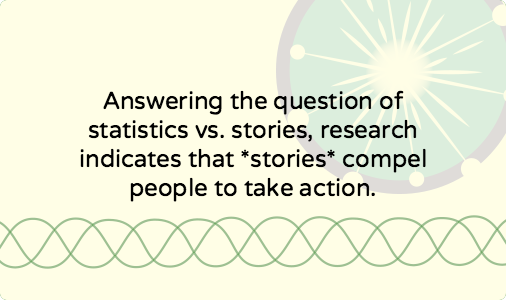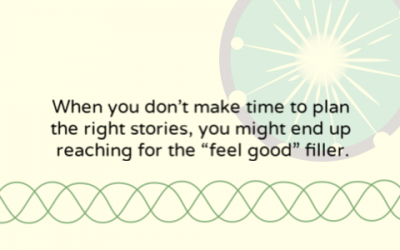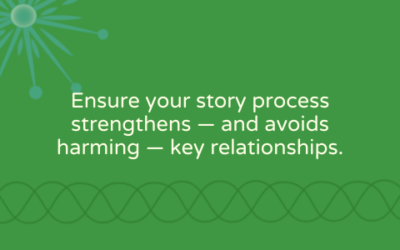Have you been advocating for more resources to support storytelling at your nonprofit organization? Would you like to add evidence from a few research studies to your case? A few months ago, I read the Storytelling Edge: How to Transform Your Business, Stop Screaming into the Void and Make People Love You by Joe Lazaukus and Shane Snow – which I recommend. The book is full of useful content for nonprofit communicators. But I was particularly excited by the descriptions of original research studies supporting the value and importance of storytelling. Because there was no bibliography or reference list in the book, I reached out to the authors. They helped to point me in the right direction and I’ve pulled together a short list for you. If you need to make a research-based case for storytelling at your nonprofit organization, check out the three studies I’ve highlighted below.
Making a case for storytelling at your nonprofit: 3 research studies
Using research to make a case for #storytelling at your #nonprofit organization: 3 studies Click To TweetThe effect of stories vs. statistics on motivation
Statistics vs. stories? Research indicates that stories compel people to take action. In a 2007 study, Deborah Small, a Wharton marketing professor, along with two colleagues, found that supporters are much more motivated by emotion and “identifiable victims” than rational appeals to help “statistical victims.” This easy-to-read review of the study, To Increase Charitable Donations, Appeal to the Heart — Not the Head, cites the following advice from Small, the study author:
“It’s all about putting together a simple, emotionally compelling message. The best way to do that is in the form of a picture or a story, something that purely engages the emotional system.”
And here’s the link to the original paper: Sympathy and callousness: The impact of deliberative thought on donations to identifiable and statistical victims. The reference to this study in the Storytelling Edge book is on page 8. Research tells us >> Stories beat statistics when it comes to motivating action (link to original study) #nonprofit #storytelling #NPMC Click To Tweet
The effect of stories on brain chemistry
In the Storytelling Edge, the authors cite a “movie theatre study” that investigated people’s physiological reactions to stories – in this case, a James Bond movie. What they found was that among other physiological reactions to the storyline, movie viewers’ brains synthesized a neurochemical called oxytocin. In my attempt to dig up the original study, I found this review by the investigator, Paul Zak: Why Inspiring Stories Make Us React: The Neuroscience of Narrative. It turns out that Zak is the researcher behind the discovery of the behavioural effect of oxytocin. This review is particularly valuable for nonprofit communicators because, through a series of video-based tests, Zak discovered that compelling narratives cause oxytocin release and have the power to affect our attitudes, beliefs, and behaviours: “Narratives that cause us to pay attention and also involve us emotionally are the stories that move us to action.” Check out the section of the review on narrative immersion which describes tests that “confirmed the causal role of oxytocin on post-narrative prosocial behavior” – including the role of oxytocin in increasing concern and increasing donations. The reference to this study in the Storytelling Edge book is on page 12. Research tells us >> Stories cause oxytocin release, which increases concern - and donations (link to original study) #nonprofit #storytelling #NPMC Click To Tweet
The power of stories to build empathy and connection
This next study established storytelling as an effective way to foster empathy, compassion, tolerance and respect for difference. The investigators found that the act of telling stories – even if they are not our own – can help to build a relationship with someone. Here’s how the Storytelling Edge authors summarize the study:
“…researchers put kids from different racial and economic backgrounds together for a series of storytime activities. The scientists found that even when the kids weren’t sharing their own stories – when they were simply reading storybooks – they developed empathy for one another. They felt more connected. And as they grew up, they were less racist and classist than other kids.”
Here’s the link to the original research: Developing cohesion and building positive relationships through storytelling in a culturally diverse New Zealand classroom. The reference to this study in the Storytelling Edge book is on page 14. Research tells us >> Stories build empathy and connection (link to original study) #nonprofit #storytelling #NPMC Click To Tweet
Bonus study: the importance of simple writing in storytelling
The book authors themselves conducted this last study. Rather than making a case for storytelling itself, it makes a case for easy-to-read, uncomplicated content. The authors analyzed a large volume of content, from celebrated novels to newspaper and magazine articles, using an automated reading-level calculator. Their conclusion: “The most popular writers on a given topic write at lower reading levels on average than their peers.” Here’s a link to the summary of this study they sent me: This Surprising Reading Level Analysis Will Change the Way You Write. Unfortunately, this post includes some broken images, but you can still get an idea of their process and the results. The reference to this study in the Storytelling Edge book is on page 38.
Can you add to this list?
Do you have any other research studies that you use to make a case for storytelling? Please add to this list by sharing your references in the comments. Making the case for storytelling at your nonprofit: 3 research studies #NPMC Click To Tweet




